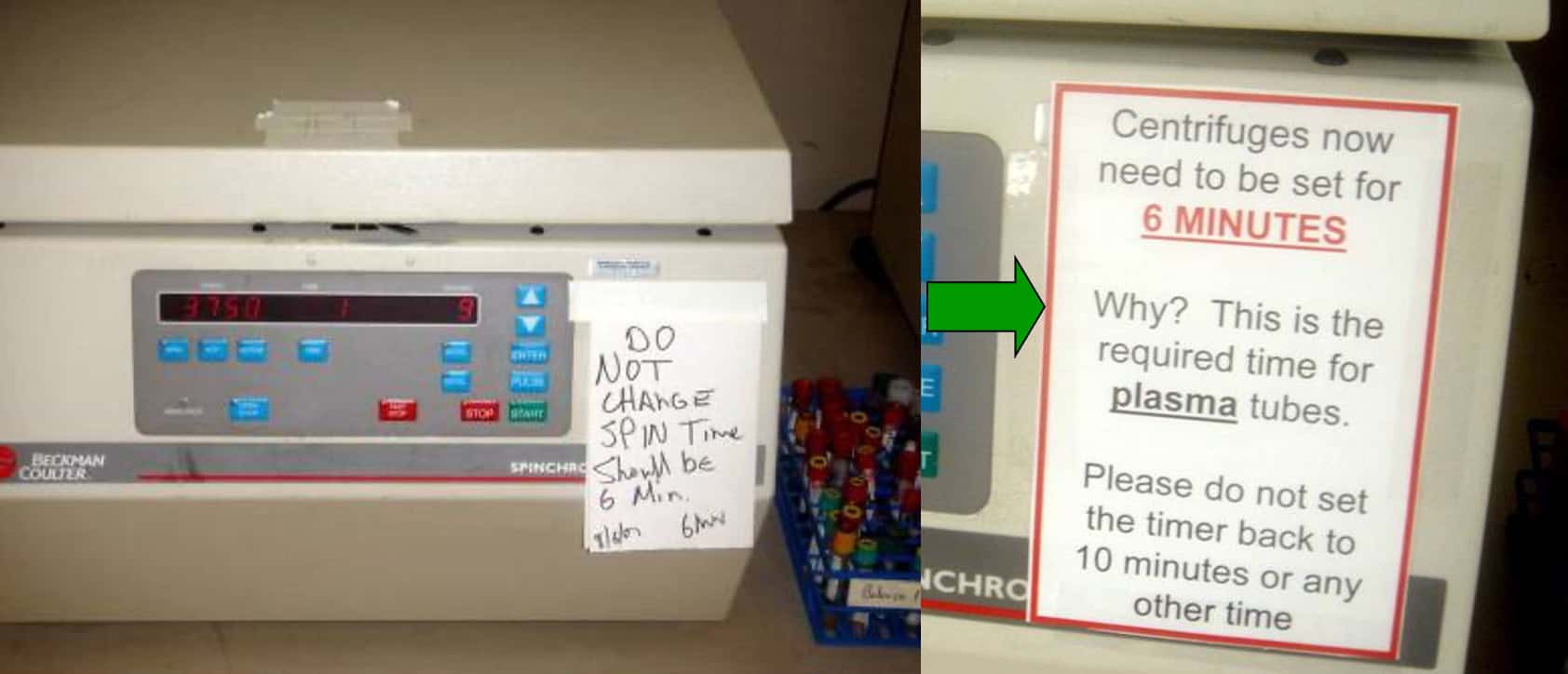In the world of continuous improvement and Lean management, clear and respectful communication is crucial. Let's take a moment to examine two different approaches to communicating a simple instruction regarding the operation of a centrifuge, as seen in the images below — pictures I took in a hospital laboratory I was working with 15 years ago or so.

On the left, we have a handwritten sign that I discovered one day that reads, “DO NOT CHANGE SPIN TIME. Should be 6 Min.” It's a direct command that leaves little room for understanding or buy-in from the team. While the intent is clear, the tone can be perceived as authoritarian and dismissive, which might not resonate well with employees. This approach assumes that the instruction is enough without providing context or reasons.
One key lesson I've learned from Toyota people is that if you need to be directive, you should explain WHY. I've seen this approach work well in many settings. I coached the team I was working with to apply that concept to a better sign. And to not rely only on a sign for communication in a small team.
Now, let's consider the sign on the right. This sign reads, “Centrifuges now need to be set for 6 MINUTES. Why? This is the required time for plasma tubes. Please do not set the timer back to 10 minutes or any other time.” This message is not only clearer but also far more respectful and informative.
The sign, again, should be either the starting point for a discussion within the team. Or it could be a follow-up reminder to a discussion about the need to keep the setting where it is. Lesson: Don't rely on signs alone, no matter how good the sign might be.
Why the Right / New Sign is Better
- Provides Context and Reasoning:
- The sign on the right explains why the centrifuge should be set for 6 minutes: it's the required time for plasma tubes. This bit of information is crucial because it helps employees understand the purpose behind the instruction. When people know why they are being asked to do something, they are more likely to comply willingly and correctly.
- Clear and Specific Instructions:
- Instead of a terse command, the sign on the right provides specific instructions about not setting the timer to 10 minutes or any other time. It anticipates possible mistakes and gently guides employees toward the correct action.
- Respectful Tone:
- The tone of the message on the right treats employees like adults who are capable of understanding and following instructions. It assumes that employees want to do the right thing and provides them with the information they need to succeed.
- Encourages Ownership and Responsibility:
- By explaining the reasoning behind the required spin time, the sign on the right encourages employees to take ownership of their work. They understand that their actions have a direct impact on the quality of the results, fostering a sense of responsibility and accountability.
Treating Employees with Respect
One of the core principles of Lean and continuous improvement is respect for people. This principle is reflected in how we communicate with our teams. Signs and instructions should not just tell people what to do, but also educate and empower them. When employees feel respected and informed, they are more engaged and motivated.
Effective communication also involves anticipating questions and potential misunderstandings. The right-hand sign does this well by addressing the common mistake of setting the timer back to 10 minutes and explaining why it should be 6 minutes instead.
Conclusion
In summary, the right-hand sign is a shining example of how to communicate effectively and respectfully with your team. By providing context, clear instructions, and maintaining a respectful tone, we not only ensure that tasks are performed correctly but also build a culture of trust and engagement. Treating employees like adults who are capable of understanding and contributing to the improvement process is fundamental to achieving lasting success in any organization.
What do you think? Please scroll down (or click) to post a comment. Or please share the post with your thoughts on LinkedIn – and follow me or connect with me there.
Did you like this post? Make sure you don't miss a post or podcast — Subscribe to get notified about posts via email daily or weekly.
Check out my latest book, The Mistakes That Make Us: Cultivating a Culture of Learning and Innovation:










[…] articleFrom Commands to Collaboration: Lessons in Respectful and Effective Workplace Signage Next articleWhy Two (or Four) Data Points Aren’t a Trend: Analyzing Olympic TV […]
[…] From Instructions to Collaboration: Classes in Respectful and Efficient Office Signage – Mark Graban takes a second to look at two totally different approaches to speaking displaying why clear and respectful communication is essential Lean administration. […]